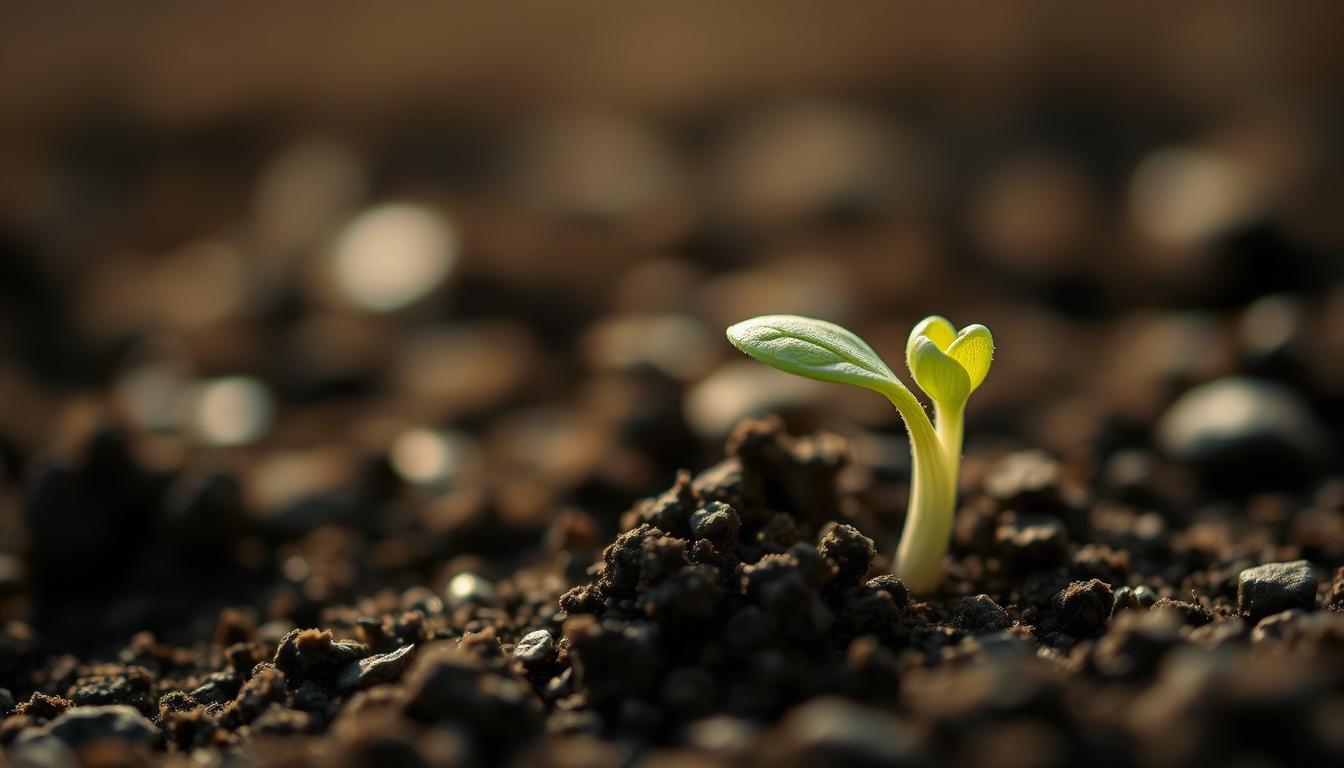Imagine starting your growing season early. With the right methods and conditions, you can speed up seed germination. This means a quicker start to your harvest. The first step to a successful harvest is getting seeds to germinate well. The best way to do this is by using the right seed starting mix.
To get seeds to germinate quickly, you need to know what affects them. This includes temperature, moisture, and light. By following the tips in this guide, you can boost your chances of successful germination. This will lead to a thriving garden.
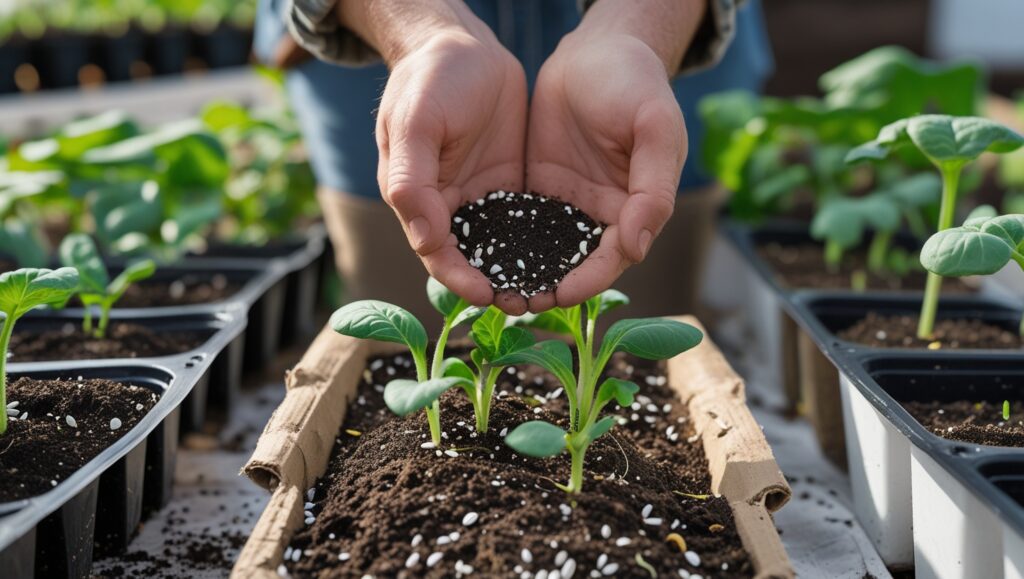
Table of Contents
Understanding Seed Germination
Seed germination is a complex process that needs specific conditions to happen. Understanding Seed Germination is key for gardeners to improve their planting plans. The best time for seed germination changes based on the seed type and the environment. For instance, some seeds need light or temperature changes to start growing, while others wait for cooler temperatures.
Germination rates can differ a lot, and things like gravity, light, and moisture affect seedling growth. Seeds start to grow faster after they absorb water, moving from a dormant state to active growth. To get the best germination, seeds need constant moisture, light, and the right temperatures.
- Temperature: Optimal soil temperatures for various vegetable crops range from 35°F to 105°F.
- Moisture: Seeds generally require soil moisture levels of 50-75% of field capacity for optimal germination.
- Light: Light exposure is critical for the development of chlorophyll in cotyledons, which may initially expand in the dark but require light to become photosynthetic.
By understanding seed germination and the best time for it, gardeners can better plan their planting. This can help increase their chances of successful germination.
Factors Affecting Germination
Several factors influence seed germination. Knowing these can help you create the best environment for your seeds to sprout fast. Temperature, moisture, and light are crucial. For example, some seeds need a certain moisture level, while others require specific light.
To get your seeds to sprout quickly, it’s important to consider these factors. The ideal conditions for germination differ by seed type. Some seeds germinate better in warm temperatures, while others prefer cooler ones. Understanding these can help you promote healthy germination and boost your chances of successful seed sprouting.
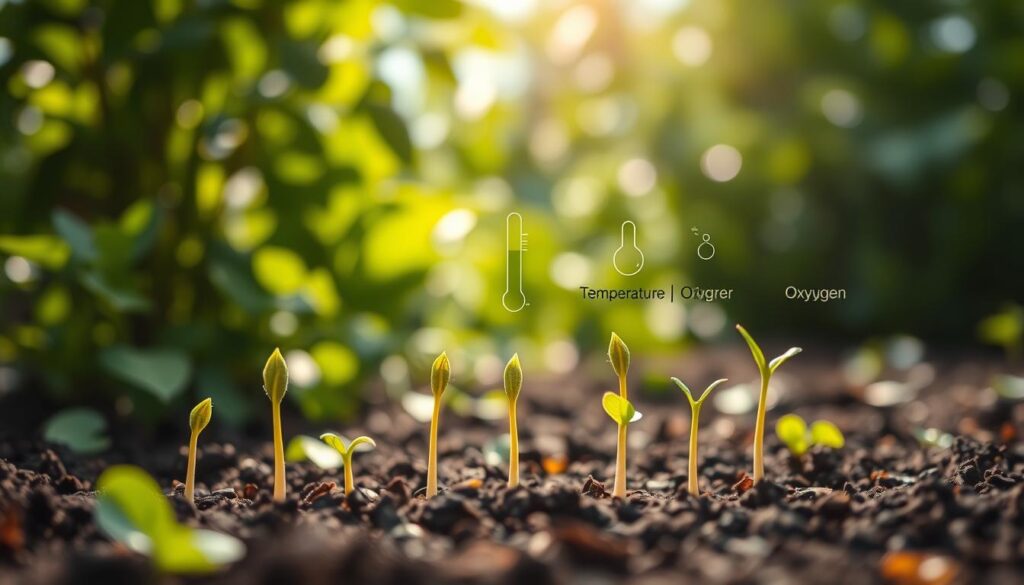
- Temperature: affects the rate of germination
- Moisture: essential for seed germination
- Light: required for some seeds to germinate
By managing these factors, you can create an environment that supports quick seed sprouting and healthy seedling growth. Remember, the key to successful germination is to provide the right conditions for your seeds to grow.
Choosing the Right Seeds
Starting your garden? Choosing the right seeds is crucial for success. With many options, picking the right ones can be tough. But, knowing the types and their traits helps for a fast seed germination process and a good harvest.
Consider if the seeds are for indoor or outdoor germination. Some, like beans, germinate fast outdoors. Others need indoor germination. Knowing your seeds’ needs ensures the best start for a fast seed germination process.
Here are key factors for choosing the right seeds:
- Germination rate: High rates mean more seeds sprout.
- Growth habits: Think about the plant’s size and growth to fit your garden.
- Disease resistance: Seeds that resist common diseases are safer.

Research and pick the right seeds for a successful garden. Always follow the seed instructions. This ensures a fast seed germination process and a great harvest.
Preparing Your Seeds for Germination
Getting your seeds ready for germination is key. This step involves several methods to boost germination success. By preparing your seeds well, you set them up for success.
First, learn how to prepare seeds. Soaking them in warm water softens the coat, helping them germinate. This works best for seeds with tough shells. Scarification, or lightly scratching the coat, also helps by letting water in and starting germination.
Using a seed starting mix is another smart move. These mixes offer the right moisture and nutrients for seed growth. By using these methods, your seeds will be ready for germination, leading to expedited seed germination and strong seedlings.
Here are some important tips for seed preparation:
- Soaking seeds in lukewarm water for several hours to aid germination
- Using a seed starting mix to provide the right amount of moisture and nutrients
- Scarification techniques to stimulate germination in seeds with hard shells
By following these tips, your seeds will be ready for germination. This means successful Preparing Your Seeds for Germination and healthier seedlings.

Timing and Planning Your Planting
Timing and planning are key for fast seed germination. Starting seeds at the right time is crucial for gardening success. Knowing when to start seeds and how to stagger planting helps you plan effectively.
Find the last frost date in your area to start seeds. Seeds usually start indoors 6 weeks before the last frost. For example, broccoli and cabbage start 4 to 6 weeks early. Celery and eggplant need 10 to 12 weeks and 8 to 10 weeks, respectively. Most seeds germinate best at 70-80°F soil temperature.
Here are some general guidelines for starting seeds indoors:
- Broccoli: 4 to 6 weeks before last frost
- Brussels Sprouts: 4 to 6 weeks before last frost
- Celery: 10 to 12 weeks before last frost
- Eggplant: 8 to 10 weeks before last frost
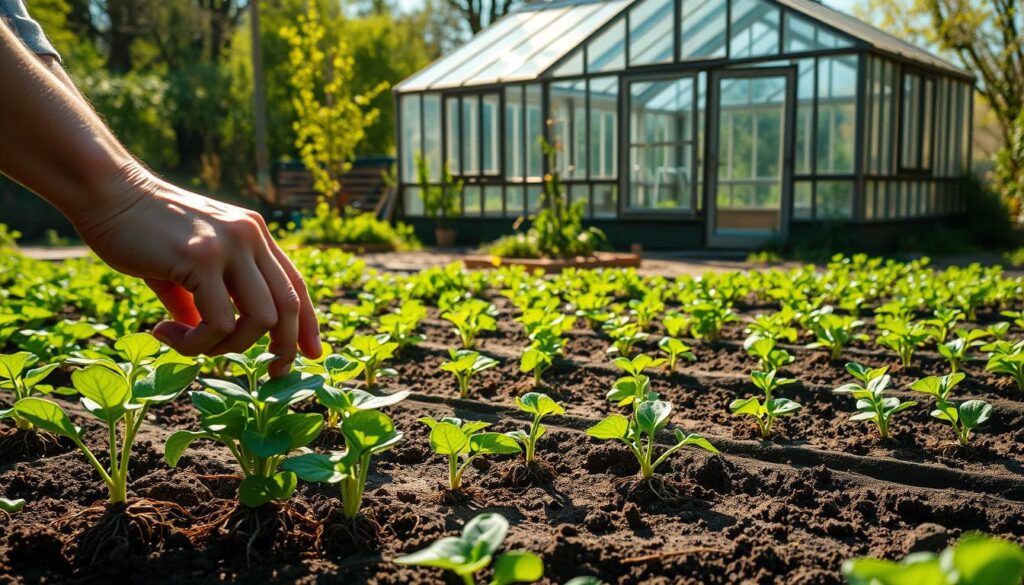
By following these guidelines, you can plan your seed starting. This leads to fast germination and a successful harvest.
Ideal Germination Conditions
To get seeds to grow well, you need to create the perfect environment. This means having the right amount of moisture, temperature, and light. Knowing what seeds need can help them grow faster and stronger.
It’s important to control the environment for seed germination. Use seed starting mixes that are clean and full of peat moss to keep moisture in. Keeping the right amount of moisture can make seedlings grow up to 25% stronger. You can also use plastic covers or seed trays with lids to keep moisture and temperature steady.
Optimal Temperature and Moisture Levels
The best soil temperature for seeds to start growing is between 65°F to 75°F (18°C to 24°C). Each seed type needs its own perfect temperature. Keeping the soil moist is hard, especially in hot places. But, with the right tools and methods, you can help seeds grow well.
Utilizing Seedling Heat Mats
Seedling heat mats can help keep seeds warm, which helps them grow. These mats make a warm, stable spot for seedlings to grow. With the right moisture and light, you can help your seeds grow their best.
Some important things to think about for ideal germination conditions include:
- Maintaining consistent moisture levels
- Providing optimal temperature ranges
- Using seed starting mixes with high amounts of peat moss
- Utilizing seedling heat mats for consistent heat
Common Germination Techniques
Exploring seed germination reveals many techniques to get seeds to sprout. Each method has its own advantages and disadvantages. You can pick the one that fits your gardening style and needs.
Some seeds need a cold period, lasting 30 to 60 days, while others soak in water for up to 24 hours. Around 400 plant species benefit from smoke to germinate. Knowing these needs is key for successful germination.
Methods for Germination
- Paper Towel Method: This method offers a warm, dark, and safe space, like soil.
- Direct Soil Sowing: Seeds are planted directly in the soil, where they can grow naturally.
- Germination in Seed Trays: This method provides a controlled environment, allowing you to manage temperature, light, and moisture.
Different seeds need different things to germinate. Some, like lettuce and petunias, need light, while others, like beans and carrots, prefer darkness. Knowing these needs helps you tailor your approach for each seed type.
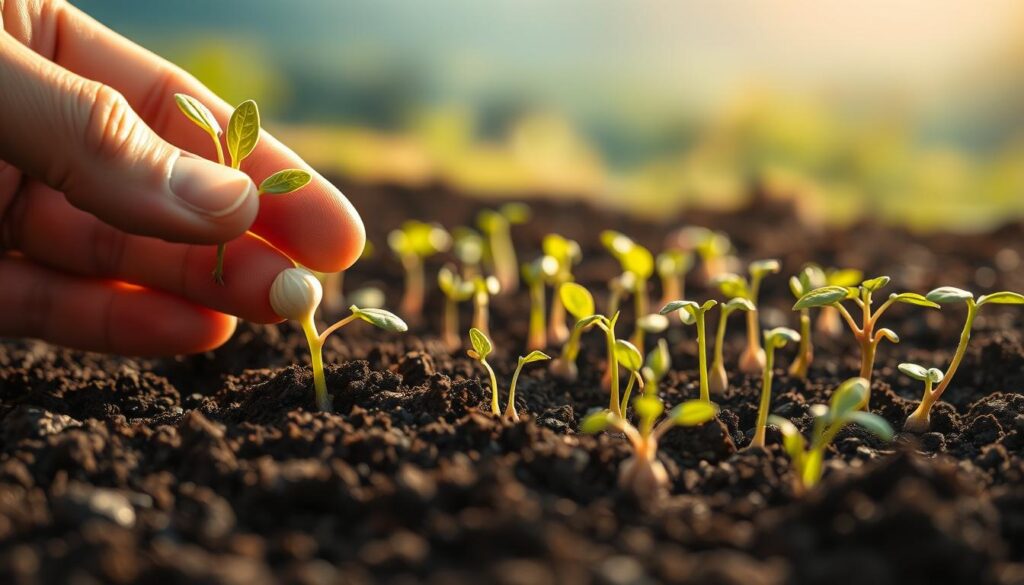
Choosing the right technique and conditions can lead to high germination rates. Keep an eye on your seeds and adjust your method as needed for the best results.
| Seed Type | Germination Time | Optimal Conditions |
|---|---|---|
| Radish | 3-5 days | 65-70°F, moist soil |
| Lettuce | 7-10 days | 65-70°F, light required |
| Tomato | 7-14 days | 85°F, well-draining soil |
Monitoring Germination Progress
Waiting for seeds to germinate can be exciting. It’s important to watch them closely. This means checking on them often to make sure they have enough moisture, light, and warmth. By doing this, you can spot any problems early and fix them.
If your seeds aren’t germinating as expected, you might need to change the temperature or moisture. This can help them grow better.
When you’re watching your seeds, remember a few things. Consistent moisture levels are key. Too much or too little water can hurt their chances of growing. Also, optimal temperature ranges differ for each plant. You’ll need to find out what’s best for yours. Soaking seeds before planting can also help them grow faster.

- Check seeds regularly for signs of germination, such as a small white root or a green shoot
- Maintain consistent moisture levels, but avoid overwatering, which can lead to fungal issues
- Provide optimal temperature ranges for your specific plant species
- Use techniques like scarification or soaking to help seeds with tough outer coatings germinate faster
By following these tips and keeping a close eye on your seeds, you can boost your chances of successful germination. Remember, patience is key. Germination times can vary a lot, depending on the plant and the environment.
Troubleshooting Germination Issues
When seeds don’t germinate, it can be really frustrating. But, knowing the common problems can help you fix them. For example, soybeans need at least 25% moisture in the soil to sprout.
Issues like pests or disease can stop seeds from growing, especially indoors. Seeds also need the right amount of moisture. If they get too dry, they can’t recover. Some seeds need cold stratification or specific light requirements to grow.
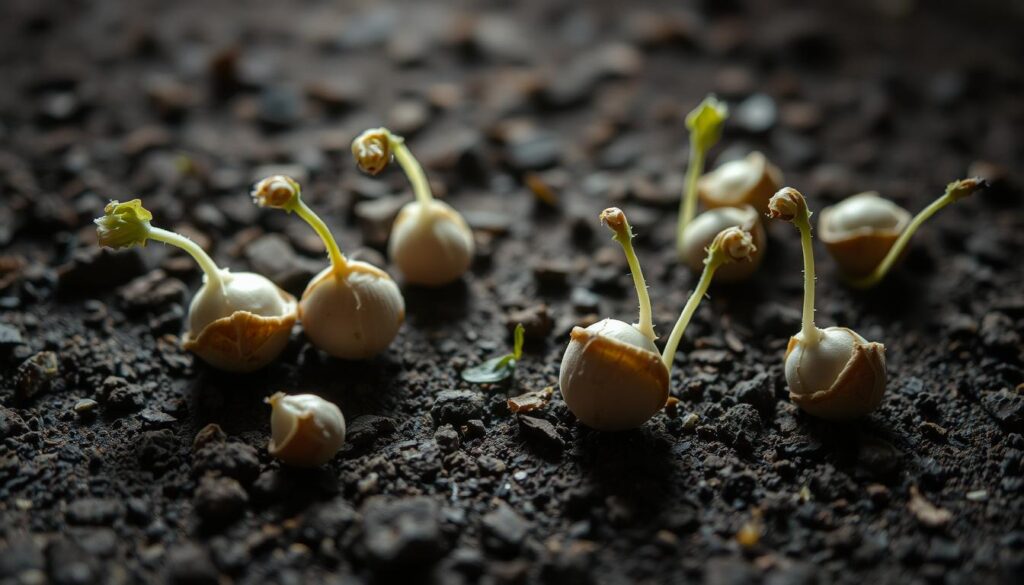
- Check the seed viability and expiration date, as certain seeds can expire more quickly than others.
- Ensure the soil temperature is within the optimal range for the specific seed type, as peppers require soil temperatures from 70°–90°F for optimal germination.
- Provide consistent moisture and avoid overwatering, which can cause seeds to rot.
By tackling these common problems, you can boost your seed germination success. This will help you grow a healthy and vibrant garden.
Transplanting Seedlings Successfully
When you’re ready to move your seedlings outside, timing and technique are key. You’ve cared for them indoors, and now it’s time to let them grow in the open air. With the right steps, your seedlings will thrive in their new home.
Check if your seedlings have at least two pairs of true leaves before moving them. This helps them adjust to outdoor life. Hardening them off for 7 to 10 days is also important. Start by letting them get morning light for a few hours, then increase the time each day.
Water your seedlings right after transplanting to help them settle. Keep the soil a bit moist, up to an inch deep. You might need to water them more often than older plants. A starter fertilizer can also help them grow strong. Here are some important tips:
- Move cool-season crops like spinach before it gets too hot.
- Warm-season crops like tomatoes and peppers should go outside when nights are over 60°F (15°C).
- Water the soil a day before transplanting to protect the roots.
- Use a thin layer of mulch to keep moisture in and weeds out.
By following these tips and transplanting carefully, you’ll have a great garden. Keep an eye on your seedlings after transplanting. Adjust their care as needed to help them grow and flourish.
Additional Resources for Seed Germination
As you explore seed germination, it’s key to keep learning and getting inspired. Whether you’re an experienced gardener or new to it, many resources can help you grow. You’ll find books, guides, online forums, and more to boost your gardening skills.
Recommended Books and Guides
For a deeper look into seed germination, check out these books and guides:
- The Seed Germination Handbook by Jane Doe – A detailed guide on the key factors for seed germination.
- Seed Starting for the Organic Gardener by John Smith – Learn organic methods for starting seeds indoors and outdoors.
- Seed to Seed: Seed Saving and Growing Techniques for Vegetable Gardeners by Suzanne Ashworth – Discover how to save your own seeds and promote genetic diversity.
Online Communities and Forums for Gardeners
Talking to other gardeners can offer great insights and support. Join these online groups to share experiences, ask questions, and learn about new seed germination methods:
- Gardeners’ World Forum – A lively community where gardeners share their knowledge and advice.
- r/Gardening on Reddit – An active subreddit for gardeners of all levels to discuss their passion.
- Growing a Greener World Forums – Explore a variety of gardening topics, including seed germination.
By using these resources, you’ll be well on your way to mastering seed germination. Happy growing!
FAQ
What is seed germination and why is it important in gardening?
Seed germination is when a seed starts to grow into a seedling. It’s a key part of gardening. Knowing how to make seeds germinate well can lead to a great harvest.
What factors affect seed germination?
Temperature, moisture, and light are the main things that affect seed germination. Knowing how these factors work together is important for getting seeds to sprout fast.
How do I choose the best seeds for fast germination?
Look at the seed type, whether it’s organic or conventional, and if it’s an heirloom. Some seeds germinate faster than others. Researching the specific needs of your seeds is crucial.
How can I prepare my seeds for germination?
You can soak, scarify, or use a seed starting mix to prepare seeds. These methods can help seeds germinate faster and increase their chances of success.
When is the best time to start germinating seeds?
The best time to start seeds depends on the plant type and your local climate. Knowing when to start and how to stagger planting helps ensure a steady harvest.
What are the ideal conditions for seed germination?
Seeds need the right temperature, humidity, and light to germinate well. Creating a controlled environment can speed up germination and improve success rates.
What are the common germination techniques used by gardeners?
Gardeners often use the paper towel method, direct soil sowing, or seed trays. Each method has its own benefits and drawbacks. Choose the one that fits your gardening style best.
How do I monitor the progress of my seed germination?
Check your seeds regularly for signs of germination, like the radicle and cotyledon. Watching your seeds closely helps you catch and fix any problems early.
What are some common issues that can arise during seed germination?
Issues like seeds not germinating, seedlings showing disease, or transplanting problems can occur. Knowing how to solve these issues is key to successful germination.
How do I transplant my seedlings successfully?
Successful transplanting involves knowing the right timing and techniques. By following the right steps, you can help your seedlings thrive and grow a healthy garden.
Source Links
- Germinating Seeds Quickly – Complete Guide – https://www.gardenmyths.com/germinating-seeds-quickly-complete-guide/
- How to Start Seeds & Germinating Seeds | Gardener’s Supply – https://www.gardeners.com/how-to/how-to-start-seeds/5062.html?srsltid=AfmBOoq-iZjW9l8eEka_yMoYqb7Pa5dt63wwl7Og8zTPhhfLYc9G7aKz
- Germination | Description, Process, Diagram, Stages, Types, & Facts | Britannica – https://www.britannica.com/science/germination
- Seed and Seedling Biology – https://extension.psu.edu/seed-and-seedling-biology
- Successful Seed Germination – https://sandiegoseedcompany.com/seed-starting/seed-germination/?srsltid=AfmBOoqfAq9sFGvYhp9Og1z4FeKSgo-x9iANZ6HJ9hwxB6Z7kksVf-wV
- Factors Influencing Seed Dormancy and Germination and Advances in Seed Priming Technology – https://pmc.ncbi.nlm.nih.gov/articles/PMC11125191/
- Conditions That Impact Soybean Germination and Emergence | Crop Science US – https://www.cropscience.bayer.us/articles/bayer/factors-that-affect-soybean-germination-and-emergence
- How Seed Soaking Affects Seed Germination – https://www.epicgardening.com/seed-soaking-germination/
- How to Start Seeds & Germinating Seeds | Gardener’s Supply – https://www.gardeners.com/how-to/how-to-start-seeds/5062.html?srsltid=AfmBOooy6cJdATtLvuDFZBQ6LWY_XkkG2iw-2QApIHwbs8yk817F5PDo
- Beginner’s Guide to Starting Seeds: Germination, Lighting, and Growth – https://hydragarden.com/blogs/blogs/beginner-s-guide-to-starting-seeds-germination-lighting-and-growth-tips?srsltid=AfmBOorXEfqNHrGvkRfly8AwjSgyJNtMf0Glefjre_8iOlOD0_NjxLzW
- How to Start Seeds & Germinating Seeds | Gardener’s Supply – https://www.gardeners.com/how-to/how-to-start-seeds/5062.html?srsltid=AfmBOopMzblb7-er5ApRaccBRzcuZLA4Peoc_ccYMSaryKGuAgZsp_EC
- Germinating Seeds Indoors Is Easier Than It Looks—Follow This Guide to Learn How – https://www.thespruce.com/how-to-germinate-seeds-8600870
- Starting Seeds Indoors: How and When to Start Seeds – https://www.almanac.com/content/starting-seeds-indoors
- How to Start Seeds & Germinating Seeds | Gardener’s Supply – https://www.gardeners.com/how-to/how-to-start-seeds/5062.html?srsltid=AfmBOooKlqWaSbDuLlJvIW4no1iJWQpAmkoUkSVUI5dhY7R0y8GF3cfl
- How to Start Seeds Indoors: The Ultimate Guide + Seedling Care Tips – https://homesteadandchill.com/seed-starting-101/?srsltid=AfmBOoqLJ_QoD_EKUKEgGKskdyX0WOUSE0NiMlKzxu4Kelk-30s3eHVt
- Successful Seed Germination – https://sandiegoseedcompany.com/seed-starting/seed-germination/?srsltid=AfmBOopnDRN6Ov70hOXDuMxwRXR4UBLrEjw4A_27S5V9ATAJ_lVOhkG4
- Soil temperature conditions for vegetable seed germination – https://extension.oregonstate.edu/gardening/soil-compost/soil-temperature-conditions-vegetable-seed-germination
- Seed Germination Techniques: Soaking, Scarifying, Stratifying, and Smoking • Insteading – https://insteading.com/blog/seed-germination-techniques/
- How to Germinate Seeds Successfully Every Time – https://www.creativevegetablegardener.com/how-to-germinate-seeds/
- How to Germinate Seeds: 5 Different Germination Methods – https://www.shopgardenrepublic.com/blogs/blog/5-different-germination-methods
- Ultimate Germination Guide: From Seeds to Sprouts – Vivosun – https://vivosun.com/growing_guide/seed-germination-guide/
- 7 Tips for Faster Seed Germination – https://www.epicgardening.com/faster-seed-germination/
- No title found – https://kochagronomicservices.com/knowledge-center/germination-game-changer
- Germination Issues and Troubleshooting – https://www.botanicalinterests.com/community/blog/germination-issues-and-troubleshooting/?srsltid=AfmBOor1fnZWJSb8QixuH6Ja5mFWfjpwRYMvWwKUFfbWbM9LPY9w1824
- Seeds Not Germinating? 12 Reasons Why and How to Fix It – https://www.epicgardening.com/seeds-not-germinating/
- The Ultimate Guide To Transplanting Seedlings – https://seedsnsuch.com/blogs/gardeners-greenroom/the-ultimate-guide-to-transplanting-seedlings
- Got Veggies? How and When to Transplant Seedlings – https://www.almanac.com/tips-transplanting-seedlings
- Seed Germination: What Do Seeds Need to Sprout? – https://www.almanac.com/germination-what-do-seeds-need
- How to Start Seeds & Germinating Seeds | Gardener’s Supply – https://www.gardeners.com/how-to/how-to-start-seeds/5062.html?srsltid=AfmBOoo-Kmg0CCYV4bG92bJQlLcamHoeJ9xaB4j9aqsUoWGTIUlC-wxo
- Starting Plants From Seed for the Home Gardener – https://extension.uga.edu/publications/detail.html?number=B1432&title=starting-plants-from-seed-for-the-home-gardener

